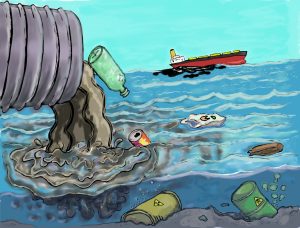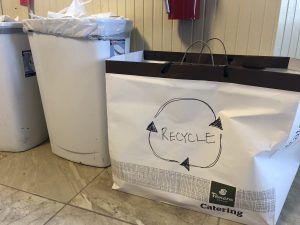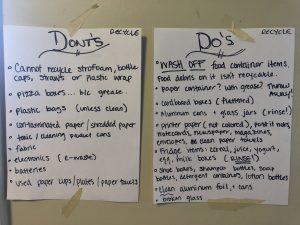What would your life look like if you made a commitment to have zero impact on the environment? We tend to not think about our personal, individual impact we have on the planet. In the last few years, the conversation to practice sustainability and human impact on the planet causing climate change has escalated and needs drastic attention and action.
No Impact Man: The Adventures of a Guilty Liberal Who Attempts to Save the Planet and the Discoveries He Makes About Himself and Our Way of Life in the Process, is a chronological year long experiment regarding leaving behind zero environmental impact from Colin Beavan, his wife, son and dog. Beavan kept a journal of their experiences which eventually turned into a book.
The idea came from his realization that he lectured about human impacts negatively affecting the planet, however he did practically nothing in his own lifestyle to alleviate the problems he was speaking about. He then decided to make a commitment to improve the planet, starting from bringing reusable bags to grocery stores and not leaving the air conditioning on all day. After extensive research, he took on much more than most of us could even imagine. He presented the zero impact process in phases:
Phase 1: Produce No Garbage
Phase 2: Produce No Carbon Emissions
Phase 3: Sustainable Eating
Phase 4: Smart Consumer Choices
Phase 5: Reduce Electricity Usage
Phase 6: Giving Back
Zero impact in this case refers to the means of leaving no garbage, carbon emissions and releasing no toxins into the atmosphere and water.
The Phases Defined
Phase one involved producing no garbage. Beavan cut out delivered food to eliminate packaging, not purchasing any items sold in packaging and avoid all disposable single-use items such as plastic water bottles, tissues and diapers.
Phase two involved not using methods of transportation that produce carbon emissions. Beavan and his wife ditched their cars and started walking to work (his wife walked 40 blocks to work in heels and wasn’t too happy) and walking nine flights of stairs to their apartment rather than taking the elevator. They, for the most part, didn’t use cars, taxis, trains or planes.
Phase three involved sustainable eating. This means consuming only local food and using nothing that was wrapped in any packaging.
Phase four encouraged smart consumer choices. This meant lessening the total amount of products purchased and instead purchased items previously owned. This phase is really essential to understand since we live in a consumption heavy world. Beavan traces much of our wasteful culture back to the “hedonic treadmill,” the notion that there is always something better out there than what was just purchased. Here are some questions to think about in your own consumption behavior: What consumer products truly improve your life? What are the true necessities? What could you do without altogether?
Phase five involved reducing electricity usage. He eliminated lights, refrigerators, dishwashers, washing machines and other appliances.
Phase sixth focused on giving back to the earth. This entailed positive-impact practices rather than elimination practices that improve the health of the environment directly. Beavan volunteered to clean up the Hudson River and help plant trees in the local communities.
Overall, the actions not only were hard to begin and implement, but also made him realize how much convenience we have in our day-to-day lives. After the experiment, he noticed how him and his family gained so much positive insight over their changed behavior and became happier with the simplicity the new lifestyle gave to them.
Personal Reflection
After reading Beavan’s book, I reflected on my own practices and how I even lecture to others to change their lifestyle habits that contribute to negative effects on the planet. I reevaluated my sustainable tactics from bringing reusable bags to grocery stores, using a metal straw and reusable metal drink containers to lowering my purchasing habits in regard to new clothes compared to second hand.
What I found about myself was disappointing. I preach out sustainable practices, yet I do very little to alleviate my personal impact on the planet. After reading this, I felt motivated to make more changes in my lifestyle habits and encourage others I live with to try the same.
This guide is designed to get the conversation going about how we can become more eco-effective as a society. Just as Beavan’s experiment has led to the launch of the No Impact Project, this guide is filled with hands-on ways you can help. At the beginning of the No Impact experiment, Colin Beavan asks, “Is it true that a guy like me can’t make a difference? Or am I just too lazy or frightened to try?”
It was more difficult this year to eliminate my waste since I live with 16 other women in one household. The three trash bins fill up every two days and are disposed of without separating out recycled items. This was weighing on me all semester. So because it’s hard to control the amount of waste the entire house eliminates, I decided to make a recycle bin in hopes that others would catch on and separate trash on their own. So far, others do recycle, even though some don’t have the knowledge on what is allowed to be recycled nor the steps needed in order for an item to be recycled, such as cleaning out the item of food debris before throwing it in the bin.
Questions To Consider
Would you be willing to personally change for a better, healthier planet and society? Would you be willing to drastically change your lifestyle habits for a greater cause? Regarding food, do you buy organic or locally at all? What about conserving waste and packaging patterns? Would you be willing to give up your car and transportation methods to decrease your carbon footprint? How realistic is this for you personally and for all of society to implement?
I suppose it all comes down to awareness, motivation, commitment, attempt and accountability to preserving the planet and all of its components.
You can determine your personal impact on the planet by calculating your ecological footprint here.



